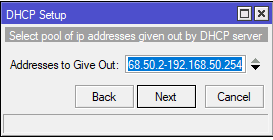Introduction
Wireless Fidelity (Wi-Fi) is a wireless connection, where data is sent via radio waves, combined with a certain frequency and amplitude. Wi-Fi has IEEE 802.11 standards and specifications using the 2.4GHz and 5GHz frequencies. In Mikrotik itself supports the IEEE 802.11a/b/g/n standard.
- 802.11a - 5GHz frequency, max 54Mbps
- 802.11b - 2.4GHz frequency, max 11Mbps
- 802.11g - 2.4GHz frequency, max 54Mbps
- 802.11n - 2.4GHz / 5GHz frequency, max 300Mbps
- 802.11ac - 5GHz frequency, max 1300Mbps
RouterOS supports various types of wireless cards, both of which work at 900Mhz, 2.4Ghz, and 5Ghz.
Wi-Fi configuration steps on the mikrotik.
After logging into the mikrotik router, the first step is to create an IP address first by going to the menu Ip => Addresses => +
In Address we enter the IP address that will be made for Wi-Fi along with the subnet mask, then in Interface we select wlan1 and for Network we leave it alone because it will be filled in automatically when we add the IP address, click OK.
By default the wlan1 interface is not active, so we have to activate it first by going to the Wireless menu => WiFi Interfaces => wlan1 => blue tick.
Next, we create a password for the Wi-Fi network, by entering the Security Profiles menu => +.
Then on the General menu, we fill in a free Name, then we enter the password that we will create in the WPA Pre-Shared Key, then in the Authentication Types option, we only check WPA PSK, then OK.
Make settings for Wi-Fi, by entering the WiFi Interfaces menu => double clicking wlan1.
On the Wireless menu, we fill in Mode: ap bridge (serves more than 1 user) then Band: 2GHz-B/G/N, then SSID (the name for Wi-Fi, fill in freely according to what we want) then Security Profile: profile1 (fill in according to the profile that was created before), then OK.
Next, we set the DNS so that the client can connect to the internet, by going to the Ip menu => DNS then we fill in Servers: 8.8.8.8 (Google DNS) then check Allow Remote Requests so that the client can use the DNS on the router, then OK.
NAT Firewall Settings, by going to menu Ip => Firewall => NAT => +.
On the General menu we fill in Chain: srcnat (internet source) then Out. Interface: ether1 (depends on the interface connected to the ISP router)
Then slide to the right, on the Action menu we fill in Action: masquerade (masquerade: functions to disguise private ip to public ip and vice versa), then OK.
Next, we fill in the Gateway to connect to the internet by going to the menu Ip => Routes => +.
Then on the General menu we fill in the Gateway with the IP address of the ISP router that is connected to our router (without using a subnet mask), then OK.
After that, we check by entering the New Terminal menu and then typing the command ping google.com. If a response appears like the one below, it's a sign that our router is connected to the internet.
Next we create a DHCP Server for Wi-Fi. First we enter the menu Ip => DHCP Server => DHCP => DHCP Setup .
Next, we select the wlan1 interface, then Next.
Next, make sure that the ip network that appears is the ip network from interface wlan1, then Next.
Here the ip from the wlan1 interface will appear automatically, if what appears is not the ip from wlan1 then we change it to the ip from the wlan1 interface, then Next.
Next, here appears the IP range that will be given to the client, we can set it ourselves as long as the IP range must be valid (an IP range that can be used for a certain subnet mask), then Next.
Next, we fill in the DNS with the DNS that we created earlier, if our router uses the DHCP Client service, several DNS ips will appear here, then Next.
Here we leave it at default, Lease Time is the length of time it takes to refresh from borrowing an IP address.























Komentar
Posting Komentar